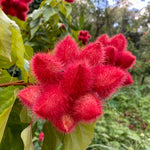Subscribe and save 10%!

Annatto tree / Achiote (Bixa orellana)
32 SEK
Unit price perExpected delivery date: 20 December to 27 December.
Applies to orders within Sweden. For other countries - see our delivery terms .
In stock - Ready to be shipped
Share
SEEDS (20pcs/bag)
Common names: Annatto Tree, Achiote, Bijol, Lipstick Tree, Aploppas, Urucu, Colorados
Scientific name: Bixa orellana
Family: Bixaceae
Plant history & use:
The annatto tree is native to South and Central America, where early Native American tribes used the red dye from the waxy seeds to make body paint and apply as lipstick. The common name Achiote comes from the Aztec word for the shrub, āchiotl .
In the modern world, it is still the seeds that are most valued in this plant, which, thanks to their bright red color and waxy texture, are well suited for dyeing of all kinds.
Annatto seeds are used to color a wide range of foods, such as butter, cheese and chocolate.
The seeds are also widely used in spice blends to enhance flavor and add color in Latin American, Caribbean, and Filipino cuisine.
Annatto is growing in popularity as a natural alternative to synthetic dyes. It can also be used as a dye and spice for rice instead of the much more expensive saffron, as the dye is chemically similar, and thus the color (Universität Graz).
Not least, Annatto is used both historically and in contemporary contexts for the natural dyeing of various textiles. For example, the plant is a popular dye in the production of silk textiles, which are produced in the traditional way by the various tribes in Laos.
A seasoning called sazón is often used in Spanish, Latin American, and Caribbean cuisine for meat and fish. The Spanish word sazón means "seasoning" or "spice" and is made with ground Annatto seeds. In addition to Annatto, cumin, coriander seeds, salt, and garlic powder are also included in the sazón mixture. In the Spanish-speaking Caribbean islands, the annatto pigment is used to season yellow rice and is sometimes added to sofrito. In the French Caribbean, it is added to a fish or pork stew called blaff .
In Brazil, a powder called colorau or colorífico is made from the ground seeds combined with filler seeds such as corn. This powder is similar to and sometimes replaces paprika. In Nicaragua, the most common way to use achiote is in the form of a paste. It is used in many national dishes, such as chancho con yuca , nacatamal , and fritanga . The Yucatán condiment called recado rojo , or "achiote paste", is made from ground annatto seeds combined with other spices and is of great importance in Mexican and Belizean cuisines.
The dye from the seeds has also been historically used as a hair dye by various Indian tribes in Ecuador.
Various plant parts from the Annatto tree are also used for a variety of medicinal purposes.
Culture:
The annatto tree likes warmth and sun. Good irrigation promotes growth, but it is actually a fairly drought-resistant plant. It needs to be overwintered frost-free, so pot growing is most suitable in Sweden.
Use a well-drained soil with a high humus content; potting soil works well.
The trees can start producing fruit (seeds) as early as 2 years of age, very early compared to other trees and shrubs. Seed production reaches its peak when the trees are about 4 - 5 years old.
Sowing:
Soak the seeds 1 day in advance. Sow indoors at the beginning of the year or outdoors from May. Sow in moist soil and cover with plastic with small holes to maintain humidity, or sow in a mini greenhouse.
Features:
Year: Perennial
Growing position: sun
Height: 6-10 m (2.5 meters in a pot in Sweden)
Germination time: 7-30 days
- Choosing a selection results in a full page refresh.
- Opens in a new window.










